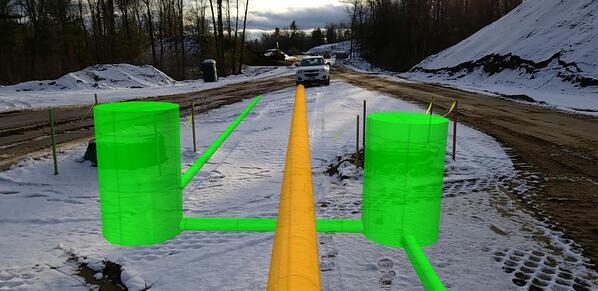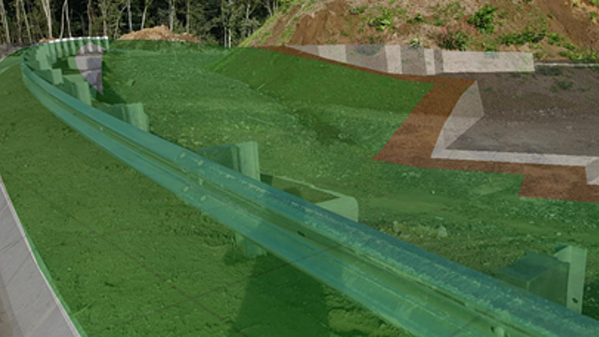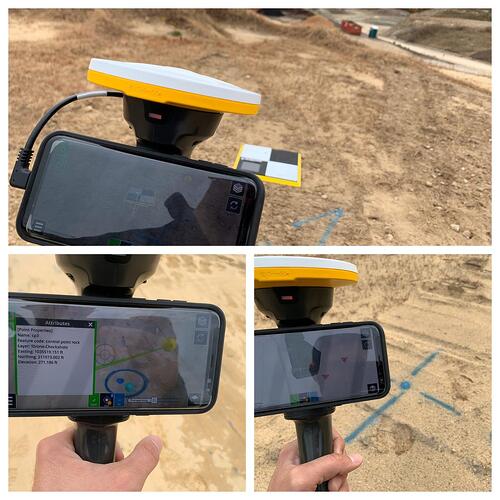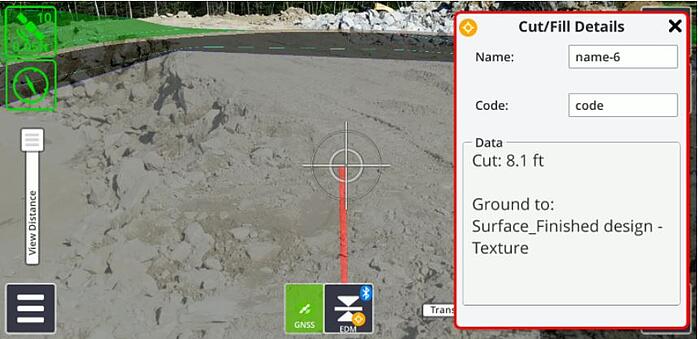The Augmented Reality Experience for a Land Excavation and Construction Company
Today we chat with project engineer Pat L’Heureux from Severino Trucking, a medium-sized land excavation and construction company based out of New Hampshire, USA. With over 170 employees, Severino Trucking delivers earthmoving and services in commercial site development, private subdivision roads, municipal road construction and New Hampshire Department of Transportation federally funded road construction
Let’s get started and learn how SiteVision has transformed Pat’s projects and get his insight on construction technology. To scroll to different sections on the post, click on the links below:
1. The Value SiteVision Brings to Projects >
2. Future Plans with SiteVision >
3. Simplifying Data with PDFs >
4. The Future of AR and VR in the Construction Industry >
 I started with Severino Trucking in high school as a general laborer. While studying Civil Engineering at the University of New Hampshire, I worked for Severino on school breaks and days off. During this time, I helped prepare takeoffs for our estimators and worked onsite at a new housing development for UNH that I ended up living at my senior year. Both positions were a great compliment to my studies, giving me real-life experience. After college, I continued estimating until I was needed in the field as a project engineer. As a project engineer, I was responsible for keeping track of pay requisitions, logging billable hours for our crews, documenting site progress, scheduling subcontractors, and ordering material.
I started with Severino Trucking in high school as a general laborer. While studying Civil Engineering at the University of New Hampshire, I worked for Severino on school breaks and days off. During this time, I helped prepare takeoffs for our estimators and worked onsite at a new housing development for UNH that I ended up living at my senior year. Both positions were a great compliment to my studies, giving me real-life experience. After college, I continued estimating until I was needed in the field as a project engineer. As a project engineer, I was responsible for keeping track of pay requisitions, logging billable hours for our crews, documenting site progress, scheduling subcontractors, and ordering material.
Pay requisitions were not bad except when it came to earthwork quantities. At the time we were quantifying most of our earthwork quantities using the average end method. One of our layout foremen on site would record points for an area documenting station, offset, elevation, and descriptions. I would then receive this information as a points file and plot these values in Bluebeam. Using Bluebeam, I was able to get an area for each station interval and then I would create a spreadsheet to generate a volume. This workflow worked but it was very slow, tedious and boring.
Given my experience with estimating I knew there was a better way. I knew I could create surfaces to get my quantities. This is when I started to delve into data prep. I started researching modeling methods, modeling everything I could, and reached out to our vendors for as much information as I could get.
Around this time, we had a gentleman leave our company, creating a void in data prep and survey support. This was a new challenge that I saw as an opportunity to greatly benefit our company. I jumped into 3D modeling, having some experience with estimating and growing experience with generating quantities, knowing this was the way we had to go, if we wanted to be successful.
“The model is a critical component but what the model really represents is effective communication.”
You are showing someone what the product is going to look like. What would take multiple cross sections, plan sheets, details, and typicals, can be shown and digested more simply as a model.
Models also share the same data to all parties involved, reducing participant redundancy and increasing the odds of catching mistakes or issues.
I have been able to grow my abilities over the years; learning, practicing, asking questions, attending conferences, learning from mistakes, and teaching when I can.
Tell us about life at Severino Trucking and what do you like doing outside of work.
I’ve been at Severino 10 years, and as a Project Engineer, I wear a lot of hats. I prepare 3D models and data for our field crews. I work with and teach our layout foreman and operators how to use our field software and machine control software. I am responsible for purchasing our survey equipment. I also do a lot with our technology integration outside of the field layout software.
This year I got my Professional Engineer (PE) license. That was a big milestone for me and my career. Everyone used to ask me what I did during my free time, and my response was, “studying.” I was studying 20 hours a week.
I’m a bit of a CAD nerd, so when I’m not working, I’m picking away at Trimble Business Center (TBC) or playing with my HoloLens, trying to discover tricks and improve workflows. To me, it is like playing a video game.
When I can peel myself away from the books and work, I spend most of my time with my family at the Lake’s region. I love boating on the water. It is a great recharge after a busy week. I also just got a French Bulldog puppy named Roo and she keeps me busy outside of work.
What sets Severino Trucking apart from other general contractors and earthmoving businesses?
We take pride in providing a quality product to our customers. We value their business and make sure we meet their project goals through hard work and innovation. When it is appropriate, we try to value engineer projects to help our customers with cost and improve constructability based on our experience with similar projects.
Could you tell us a bit more about who your customers are?
We are one of the leading contractors in New Hampshire. Our scope of work ranges from small subdivisions, municipal roads and utility upgrades, large shopping plazas to large highway construction. Some of our customers include New Hampshire DOT, developers for Lowe’s, Staples, and multiple cities and towns throughout New Hampshire.
What field and office software and equipment are you currently using?
In the field, we use Trimble SiteWorks, Carlson SurvCE, Trimble Earthworks, and the GCS900. We also use Trimble SiteVision, Bluebeam, SketchUp, and Trimble Business Center. Our estimators use Agtek Earthwork 4D for Earthwork take-offs.
How did you discover Trimble SiteVision?
One of my goals has been to find a portable, affordable device that anyone could walk around with and get the information they need. I have been fortunate enough to experience quite a few roles which have afforded me a better understanding and appreciation for how everything ties together.
There is a definite disconnect between the field and office, in our company and as an industry. These groups are treated as separate entities, not efficiently sharing data and there is a lot of redundancy, inefficiency, and error that gets introduced. However, these are not separate groups. These groups are all working together for the same goal; to complete quality work on time. They need the same data. Their uses may be different requiring different interfaces but why do I need to have x,y,z files for my field crews and a,b,c files for my office. Crazy! At the end of the day, the core data is all the same, it needs to be because we are building the same concept, idea, or product.
If we want to exceed the limits of paper, we need to make the distribution of this new age information as easy as passing out a piece of paper. Smart devices such as phones and tablets are crucial components to the evolution. A company that recognizes effective communication and collaboration between various groups; from engineers, to office staff, to the crews, is a must. I think Trimble is making great advances in this area and working hard to address these issues.
“There are no search bars on paper. No auto tabbing. No jump to. No quick digitizing in the field, and paper takes up so much space.”
Over the years, I have investigated numerous products trying to find a replacement for paper. There were good options, but they all had their quirks; expensive software, expensive hardware, poor specs for running multiple software programs, not user-friendly, proprietary file types, sharing data, etc.
I didn’t get discouraged though. I continuously reached out to my dealers, asking what they had available, hounding them to make suggestions to developers and when opportunities permitted bending the ears of product managers and developers on why we needed a portable device. One of my conversations with Casey Cyrus led me to SiteVision and I have been hooked ever since.
SiteVision allows users with Android phones to bring complex data sets to the field and very efficiently present this data in a user-friendly format. I look forward to seeing how this product and concept evolves further.
“SiteVision brings the wow factor of AR to the field. Having that portable, very reasonably priced portable device is important.”
What is the value that Trimble SiteVision brings to your projects?
We have a lot of good smart data, but outside of Trimble Business Center, it becomes a lot harder to share. SiteVision is a good way of sharing that smart information – adding value to our data workflows and communicating designs.
We were working on a design build project and I was able to show everyone at a site meeting exactly what the project was going to look like with the use of SiteVision. SiteVision is a great tool to present data to all parties involved; investors, engineers, contractors, neighboring owners and users. Having the model present at meetings takes a lot of questions out of the equation and presents the data in an easy format that anyone can understand. You can tell you have a good model when it blends well into existing conditions.
Experience has given me the ability to take 2D plans and mentally see them in 3D. But with SiteVision, you don’t need years of experience of looking at plans to do this. You know what the product will look like instantaneously, in even more detail than you would get from a 2D data set. You can streamline a skill that can take years to acquire and even once acquired still has limitations.
 “People still use plans, and pen and paper, because you can pick it up and give it to anyone. SiteVision replaces that…”
“People still use plans, and pen and paper, because you can pick it up and give it to anyone. SiteVision replaces that…”
Do you like that SiteVision supports loading PDF plans?
I think it is great and I wish we would’ve had SiteVision five years ago. In the construction industry, we have some fancy tools – augmented reality, machine automation, but having the ability to view PDF plans in SiteVision will be a good stepping stone for people to get introduced and acclimated to the technology. You can take an estimator that’s not used to 3D models, or a project manager, and at least give them the ability to go out on site and see the plan in context.
The ability to send a PDF to the field can also be quicker than preparing a model. There is a lot of time and work that goes into creating a model. I can very quickly take a PDF, export it out of TBC with coordinates, and have it ready for the field to use. If we’re just doing conceptual planning, it’s much easier and quicker.
Learn how to visualize 2D Plans in Trimble SiteVision with this “How To” Video >
If you had to summarize your experience with SiteVision so far, what would you say?
I would say one of the best things is the ability to take a model that you’ve invested a lot of time in, go onsite, and work with different parties onsite showcasing this work. SiteVision allows you to show and get that tangible aspect of the model before the project’s built.
A lot of times, you build these models and you don’t see it all come together until the end of the project. But now you can go out and check. You can keep track and teach people why you may have designed something a certain way and get a better grasp on how something is.
The person designing the project or creating model can learn as well from seeing things being constructed, seeing the difference between what works on paper but what doesn’t in 3D space. An engineering firm could provide these to their field inspectors for tracking the progress of the job.
SiteVision is a great learning and teaching tool.
How did other team members onsite react to Trimble SiteVision?
At first, people think I am crazy, which I am now use to. But once they see SiteVision in action, most are flabbergasted.
I was walking around with one of our project superintendents on a new site and he was blown away by the technology. We were able to look at 3D utilities, get some cut and fill measurements and literally see the project before our eyes. It is a funny and great feeling to walk around with someone and see their face light up and hear them whisper “wow.”
“Pallets of grade stakes. Cases of paint. Stacks of plans. All in the palm of your hand.”
What kinds of projects are you planning to use Trimble SiteVision on?
I plan to use SiteVision on as many projects as I can. I think the system doesn’t have a limitation where I would say “Nah, I don’t want to see that in 3D”. Why wouldn’t you?
I think my biggest road block is the data prep. There are some differences in the models that I use for SiteVision versus the models my layout crews use. As tools in Trimble Business Center advance, the parametric vertical design tool for instance, the data prep process becomes easier and the data becomes more universal. The SiteVision AR exporter for TBC has been another great tool that has helped streamline data prep. I look forward to using this to send utility data to SiteVision devices.
I cannot wait to use SiteVision on a project from start to finish and see how this helps in the different project phases; bidding, value engineering, construction, progress tracking, and project completion review.
 Measuring control points prior to checking stockpile locations
Measuring control points prior to checking stockpile locations
If you were to pick one of your favorite features of SiteVision at the moment, what would it be?
As an earthwork contractor, I really like the integrated cut and fill measurements. Outside of seeing the model real-time, I think it’s a very valuable tool to gauge progress. It’s also a safety tool. Now you can check cuts and fills in areas where you couldn’t get to safely, such as mining operations.
Have you been using the EDM for cut-fill measurements? Or the GNSS, or an equal combination of both?
I typically use EDM. It is very quick and easy. The EDM measurements are great for hazardous situations. I find the accuracy adequate for quantity and quality checks.
Do you think augmented reality and virtual reality, and mixed reality are transforming the construction industry?
It’s an absolute game-changer. You can find mistakes faster and communicate with everyone onsite and offsite very easily and quickly with no need for paper plans. It grabs attention. If I run into an issue with a model, I make a video of it calling out concerns and suggesting alternatives, I send it off, and it’s like we just had a meeting onsite by utilizing that AR technology without greatly tying up people’s time.
Do you think that technology like SiteVision, and HoloLens, encourages young people to be involved in the construction industry?
Oh without a doubt. That’s why I love doing what I’m doing. Not only does technology help make things faster, but it helps to make to things more fun.
Designers have been creating 3D models for a while but until recently there wasn’t a great way of sharing that information to other parties. Designers had to resort to plan view, cross sections, profiles and details. All very valuable but they take a lot of time to compose. When you get to a certain stage, these deliverables tend to lose their dynamic ties to the modal and changes start to become manual. This is usually when you see discrepancies between sheets or view because someone will update one piece of the plan and not its counterpart.
3D viewing software allows users to keep the data in 3D space longer, if not for the duration of its use, and dramatically reduces the work that it takes to create 2D plans that represent a 3D object.
“You can’t find 3D mistakes in 2D, and that is why I love modelling”
In the construction industry, we are still using a lot of antiquated methods. They work, but they are not the most effective and some take a lot of extra time than newer methods. Some of the older methods are also very dry, like digitizing. When you ask why these are still being used, you usually get “Well that’s how we’ve always done it”. We need to break this thought process.
One of my friends used to joke with me “Oh you just dig holes”. We had a conversation the other day about different work topics and I started showing him how I use a drone, work with AR with both HoloLens and SiteVision, I work with large scale 3D printers (machine control). He turned to me and said ” Sorry man, I was wrong. You’re freakin’ Ironman”.

SITECH Northeast is proud to aid Severino Trucking in their earthmoving projects and quests to increase their use of technology on their sites. Their adoption of the Trimble Earthworks machine systems has been beneficial to our ability to get operators more productive in a shorter period of time. The addition of SiteVision to their technology tools has enhanced the ability to bring more than just the operators up to speed on a project. Pat’s use of SiteVision provides no limits to his education of the Severino crews as they tackle projects looking to increase efficiency. Sitech Northeast provides the SiteVision product to the six states we cover, Maine, New Hampshire, Vermont, Rhode Island, Massachusetts and Upstate New York, as a tool to gain more work, do more work, and make more money. A better understanding of what is being built by all those involved always results in a better outcome of the project.
More Trimble SiteVision
Subscribe to the Trimble SiteVision blog so you'll be alerted with the latest posts.

